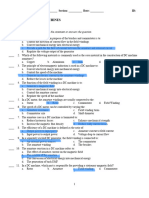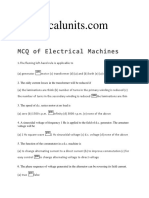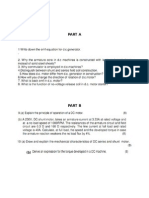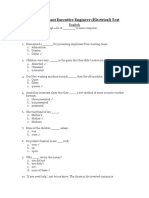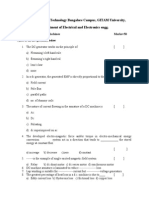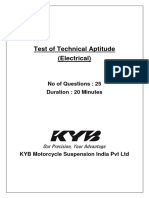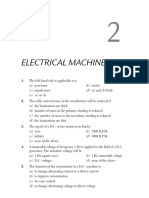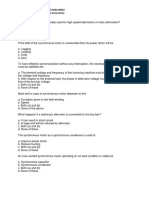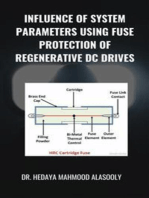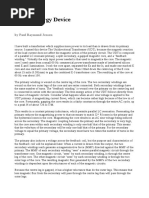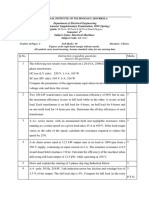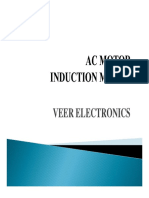0%(1)0% found this document useful (1 vote)
127 viewsAc and DC Machines Objectives Type Questions
Ac and DC Machines Objectives Type Questions
Uploaded by
John Norie Baydal1. The document contains 50 multiple choice questions about AC and DC machines objectives and their types. The questions cover topics like speed control methods of DC motors, speed calculation of AC generators based on pole numbers, reasons for using carbon brushes in DC machines, components of DC machines like armature windings, field poles, and methods to improve voltage regulation.
2. The questions test understanding of concepts like armature reaction, torque characteristics of different DC motor types, losses in electric machines, brush properties, alternator excitation and load regulation, parallel operation characteristics.
3. Applications of different motor types for loads like elevators and punch presses are also questioned.
Copyright:
© All Rights Reserved
Available Formats
Download as PDF, TXT or read online from Scribd
Ac and DC Machines Objectives Type Questions
Ac and DC Machines Objectives Type Questions
Uploaded by
John Norie Baydal0%(1)0% found this document useful (1 vote)
127 views6 pages1. The document contains 50 multiple choice questions about AC and DC machines objectives and their types. The questions cover topics like speed control methods of DC motors, speed calculation of AC generators based on pole numbers, reasons for using carbon brushes in DC machines, components of DC machines like armature windings, field poles, and methods to improve voltage regulation.
2. The questions test understanding of concepts like armature reaction, torque characteristics of different DC motor types, losses in electric machines, brush properties, alternator excitation and load regulation, parallel operation characteristics.
3. Applications of different motor types for loads like elevators and punch presses are also questioned.
Original Title
Untitled
Copyright
© © All Rights Reserved
Available Formats
PDF, TXT or read online from Scribd
Share this document
Did you find this document useful?
Is this content inappropriate?
1. The document contains 50 multiple choice questions about AC and DC machines objectives and their types. The questions cover topics like speed control methods of DC motors, speed calculation of AC generators based on pole numbers, reasons for using carbon brushes in DC machines, components of DC machines like armature windings, field poles, and methods to improve voltage regulation.
2. The questions test understanding of concepts like armature reaction, torque characteristics of different DC motor types, losses in electric machines, brush properties, alternator excitation and load regulation, parallel operation characteristics.
3. Applications of different motor types for loads like elevators and punch presses are also questioned.
Copyright:
© All Rights Reserved
Available Formats
Download as PDF, TXT or read online from Scribd
Download as pdf or txt
0%(1)0% found this document useful (1 vote)
127 views6 pagesAc and DC Machines Objectives Type Questions
Ac and DC Machines Objectives Type Questions
Uploaded by
John Norie Baydal1. The document contains 50 multiple choice questions about AC and DC machines objectives and their types. The questions cover topics like speed control methods of DC motors, speed calculation of AC generators based on pole numbers, reasons for using carbon brushes in DC machines, components of DC machines like armature windings, field poles, and methods to improve voltage regulation.
2. The questions test understanding of concepts like armature reaction, torque characteristics of different DC motor types, losses in electric machines, brush properties, alternator excitation and load regulation, parallel operation characteristics.
3. Applications of different motor types for loads like elevators and punch presses are also questioned.
Copyright:
© All Rights Reserved
Available Formats
Download as PDF, TXT or read online from Scribd
Download as pdf or txt
You are on page 1of 6
AC AND DC MACHINES OBJECTIVES TYPE QUESTIONS
1. The most commonly used method of speed control of a DC motor is by
varying
a. Voltage applied to the motor
b. Field strength
c. Effective number of the conductor in series
d. Armature circuit resistance
2. What should be the speed of a 6-pole ac generator in order to have a
frequency of 50 Hz? Note: n= 120f /P
a. 1000 rpm
b. 500 rpm
c. 1000 rpm
d. 1500 rpm
3. For what reason, why carbon brushes widely used in DC machines?
a. It is abundant
b. It is cheap
c. It has a high voltage drop
d. It lubricates and polishes the contacts
4. What is the better alternative to reduce further the ripples?
a. Truncation
b. Clipping
c. Clamping
d. Regulation
5. The effect of armature reaction is to ______________.
a. decrease the total flux
b. Make the air gap flux uniform
c. Increase the total flux
d. Make the flux constant
6. Among the dc motors, which produces the highest torque?
a. Series
b. Shunt
c. Compound
d. Differentially compounded
7. The commutator pitch for a simplex lap winding is equal to
a. Number of poles on the machine
b. One
c. Pole pairs
d. 2
8. In a wave winding, the commutator pitch is approximately equal
to_________________.
a. Pole Pitch
b. Thrice the pole Pitch
c. Twice the pole Pitch
d. Half the pole Pitch
9. The voltage regulation of an alternator with a power factor of 0.8
lagging is_____________ at unity factor.
a. Greater than
b. The same as
c. Smaller than
d. 100%
10. Considered as a variable speed motor.
a. Compounded
b. Differentially Compounded
c. Shunt
d. Series
11. A separately excited dc generator is not used because
a. it is costly
b. a separate dc source is required for the field circuit
c. voltage drops considerably with load
d. it is bulky
12. The field winding of an alternator is_____________excited.
a. dc
b. ac
c. both ac and dc
d. battery
13. The air gap in an alternator is___________ in an induction
machine.
a. much shorter than
b. about the same as
c. much longer than
d. one-half than
14. When the load on an alternator is increased, the terminal
voltage increases if the load power factor is__________.
a. unity
b. leading
c. lagging
d. zero
15. The effect of the armature reaction is_____.
a. decrease the total flux
b. make the air gap flux uniform
c. increase the total flux
d. make the flux constant
16. The yoke of a dc machine is made of________.
a. silicon steel
b. aluminum
c. soft iron
d. cast steel
17. The field structure of a dc machine uses_________.
a. salient pole arrangement
b. non-salient pole arrangement
c. silicon steel
d. cast steel
18. Armature reaction in a dc motor is increased
a. when the armature current increases
b. when the armature current decreases
c. when the field current increases
d. by inter-poles
19. Carbon brushes are used in a dc machine because______.
a. carbon lubricates and polishes the commutator
b. contact resistance is decreased
c. carbon is cheap
d. carbon is abundant
20. Which dc machines are most common?
a. 2 poles
b. 6 poles
c. 4 poles
d. 8 poles
21. The loss is due to the reversal of magnetization of the
armature core.
a. eddy current
b. hysteresis loss
c. bearing
d. windage
22. Which is the most suitable motor for the elevator?
a. series
b. differentially compounded
c. shunt
d. cumulatively compounded
23. Small dc machines generally have _____poles.
a. 4
b. 2
c. 6
d. 8
24. Factor(s) that affect iron losses in a dc motor is_______.
a. flux
b. speed
c. armature resistance and flux
d. A and B are correct
25. In a lap winding, the number of brushes required is equal
to____.
a. number of poles
b. commutator pitch
c. the number of pairs of poles
d. number of coils
26. The torque developed by a dc motor is directly proportional
to______.
a. flux per pole x armature current
b. armature resistance x applied voltage
c. armature resistance x armature current
d. flux per pole x applied voltage
27. Back emf in a dc motor is maximum at _________.
a. no load
b. half full-load
c. full load
d. ¾ full load
28. The brush voltage drop in a dc machine is about ________.
a. 0.1 v
b. 2 v
c. 10 v
d. 20 v
29. DC machines that are subjected to abrupt changes of load are
provided with
a. interpole windings
b. compensating windings
c. equalizers
d. c0pper brushes
30. The distribution of load between two alternators operating in
parallel can be changed by changing_______.
a. phase sequence
b. field excitation of alternators
c. driving torques of prime movers
d. current direction
31. The field winding of a dc shunt machine usually
carries_________ of the rated current of the machine.
a. 2% to 5%
b. more than 20%
c. 15% to 20%
d. less than 0.5
32. If the excitation of an alternator operating in parallel with
other alternators is increased above the normal value of excitation,
its
a. power factor becomes more lagging
b. output current decreases
c. power factor becomes leading
d. output kW decreases
33. What is the voltage regulation when the full load voltage is
the same as no load voltage assuming a perfect voltage source?
a. 100%
b. 1%
c. 10%
d. 0%
34. Why do in the dc motor, brushes positioned such that they will
be with the direction of the rotation?
a. to reduce sparking
b. to last long
c. to have less loss
d. all of them
35. 35. Which is the most suitable for punch presses?
a. shunt motor
b. differentially compound motor
c. series motor
d. cumulatively compound motor
36. Overhearing of a dc motor is due to _______.
a. insufficient end play
b. overloads
c. loose parts
d. rough commutator
37. The stator of an alternator is wound for _________on the rotor.
a. more number of poles than
b. the same number of poles as
c. less number of poles than
d. twice the number of poles than
38. A graphical relation between the generated emf and the field
current of a machine.
a. current generation curve
b. voltage generation curve
c. voltage-current curve
d. magnetization curve
39. The deciding factor in the selection of a dc motor for a
particular application is its________characteristics.
a. speed-torque
b. torque-armature current
c. speed-armature current
d. speed
40. The rotor of a turbo-alternator is made cylindrical in order
to reduce.
a. eddy current loss
b. windage loss
c. hysteresis loss
d. copper loss
41. The nature of the armature winding of a dc machine is decided
by_____.
a. front pitch
b. back pitch
c. commutator pitch
d. number of coils
42. DC machines that are subjected to abrupt changes of load are
provided with____.
a. interpole windings
b. compensating windings
c. equalizers
d. copper brushes
43. The armature winding of a dc machine is _____winding.
a. an open-circuit
b. a closed-circuit
c. partly open-circuit and partly closed-circuit
d. lap
44. What is true about field poles in electric machines?
a. there are always even number of them (exist by pair)
b. there are always an odd number of them
c. there are always an even or odd number of them
d. none of them
45. The alternators driven by ________do not have a tendency
a. diesel engines
b. steam turbines
c. water turbines
d. prime movers
46. For 20% increase in current, the motor that will give the
greatest increase in torque is _______motor.
a. shunt motor
b. differentially compound motor
c. series motor
d. cumulatively compound motor
47. The efficiency of the turbo-alternator_______with increase in
speed.
a. decreases
b. remains the same
c. increase
d. become 100%
48. The main drawback of a dc shunt generator is that_______.
a. terminal voltage drops considerably with load
b. shunt field circuit has high resistance
c. generated voltage is small
d. it is expensive
49. When an armature open in dc motor, it may cause____.
a. intermittent sparking
b. an increase in speed
c. the motor to slow down
d. the motor to stop rotating
50. It consists of a single coil rotated in a magnetic field and
produces an AC voltage.
a. field winding
b. armature
c. commutator
d. elementary generator
You might also like
- RME REE Review QuestionsDocument33 pagesRME REE Review QuestionsReneboy Lambarte0% (1)
- Power System Stability McqsDocument12 pagesPower System Stability Mcqsdr.Sabita shrestha100% (4)
- Questions & Answers On DC MachinesDocument32 pagesQuestions & Answers On DC Machineskibrom atsbha75% (4)
- 08 Resolver ADocument32 pages08 Resolver AMaria Lunes0% (1)
- Ee PreboardDocument5 pagesEe PreboardHarmon SolanteNo ratings yet
- Acdc Quiz1Document7 pagesAcdc Quiz1Ejay ReyesNo ratings yet
- Ree Board Exam 1Document10 pagesRee Board Exam 1Hector0% (1)
- Rme Exam 1 Set BDocument4 pagesRme Exam 1 Set Baeilorv infante100% (1)
- RME AC Technical SubjectsDocument10 pagesRME AC Technical SubjectsRuben MonticalvoNo ratings yet
- F2 (Oic)Document246 pagesF2 (Oic)Kate LibresNo ratings yet
- DC Motor QuizDocument6 pagesDC Motor QuizOmagCharmaineBalisongNo ratings yet
- Exit Exam ece electrical machines 2023 (3)Document12 pagesExit Exam ece electrical machines 2023 (3)danielmesganaw707No ratings yet
- MCQ of Electrical MachinesDocument78 pagesMCQ of Electrical Machineskibrom atsbha100% (2)
- QuizDocument5 pagesQuizgeetikag_23No ratings yet
- Refresher - Elex 2 (April, 2007)Document8 pagesRefresher - Elex 2 (April, 2007)Aylie PilobelloNo ratings yet
- Activity 1 Synchronous GeneratorDocument7 pagesActivity 1 Synchronous GeneratorReinz 0429No ratings yet
- Electrical Test Paper 3Document4 pagesElectrical Test Paper 3Ameer HamzaNo ratings yet
- BEE Objective Question Bank With Answers Mid IIDocument6 pagesBEE Objective Question Bank With Answers Mid IIsiddenkigouthamNo ratings yet
- BEE Objective Question Bank Mid IIDocument5 pagesBEE Objective Question Bank Mid IIsiddenkigouthamNo ratings yet
- D.C Question 1Document10 pagesD.C Question 1RathinaKumarNo ratings yet
- MCQ Machine - SheetDocument10 pagesMCQ Machine - Sheetmahmoud sobhiNo ratings yet
- Comprehension - I: o o o oDocument5 pagesComprehension - I: o o o oGeetha AnbazhaganNo ratings yet
- EE-422-Final-Examination PETE 2207Document6 pagesEE-422-Final-Examination PETE 2207Christian Rogel De TorresNo ratings yet
- DC Motor WorksheetDocument4 pagesDC Motor WorksheetThomas AgegnehuNo ratings yet
- Assistant Executive Engineer 2018 TEST PDFDocument12 pagesAssistant Executive Engineer 2018 TEST PDFMuhammad Umair AslamNo ratings yet
- FPSC ElectricalDocument12 pagesFPSC ElectricalMustafa Shaykh100% (1)
- Questions On Electrical Machine Applications Armature Reaction and CommutationDocument12 pagesQuestions On Electrical Machine Applications Armature Reaction and Commutationkibrom atsbhaNo ratings yet
- 4Document41 pages4Abhishek KarmakarNo ratings yet
- ElectronicsDocument11 pagesElectronicsLaurence ConsignadoNo ratings yet
- RME REE Review QuestionsDocument32 pagesRME REE Review QuestionsAllan BitonNo ratings yet
- DC Motors PracticeDocument7 pagesDC Motors PracticeJessica AldaNo ratings yet
- MCQ of D.C GeneratorsDocument29 pagesMCQ of D.C Generatorskibrom atsbha67% (3)
- MCQ of D C GeneratorsDocument29 pagesMCQ of D C Generatorskaloy33100% (3)
- Aces Objectives 7 EEDocument6 pagesAces Objectives 7 EEvenjaytabagoNo ratings yet
- Lec6 - DC MachinesDocument17 pagesLec6 - DC MachinesjunryNo ratings yet
- GC-8 Basic ElectricityDocument6 pagesGC-8 Basic Electricityyihesak100% (1)
- Ee Objective Q 1Document34 pagesEe Objective Q 1Kokan BalucasNo ratings yet
- MotorsDocument11 pagesMotorsMizhar GerardoNo ratings yet
- GITAM School of Technology Bangalore Campus, GITAM University, Department of Electrical and Electronics EnggDocument4 pagesGITAM School of Technology Bangalore Campus, GITAM University, Department of Electrical and Electronics EnggAnand KalNo ratings yet
- D C ELECTRIC 1Document25 pagesD C ELECTRIC 1isaacNo ratings yet
- Multiple Choice Questions DCM A SecDocument1 pageMultiple Choice Questions DCM A Seckanda71No ratings yet
- Questions & Answers On Motor Control by Static Power ConvertersDocument12 pagesQuestions & Answers On Motor Control by Static Power Converterskibrom atsbha100% (2)
- Refresher Day 18Document3 pagesRefresher Day 18Jevan A. CalaqueNo ratings yet
- Tangedco Eee 2Document122 pagesTangedco Eee 2rigNo ratings yet
- 9.1 ElectDocument12 pages9.1 ElectisaacNo ratings yet
- Electrical Machine Lab - Print - QuizizzDocument4 pagesElectrical Machine Lab - Print - QuizizzraygharNo ratings yet
- UPDA (96 Page PDF) - Motors SectionDocument9 pagesUPDA (96 Page PDF) - Motors SectionAbdelhamid BenallelNo ratings yet
- Ee300mcqwww.allexamreview.comDocument68 pagesEe300mcqwww.allexamreview.comajayvarma02626No ratings yet
- AltermacDocument28 pagesAltermacAC CuetoNo ratings yet
- Jntu Online Examinations (Mid 2 - Et)Document18 pagesJntu Online Examinations (Mid 2 - Et)venkat gautam100% (2)
- 2.0 Test of Technical Aptitude (Elect) - All - RemovedDocument5 pages2.0 Test of Technical Aptitude (Elect) - All - RemovedMuvvala Santosh KumarNo ratings yet
- Electrical Machine MCQDocument56 pagesElectrical Machine MCQmohammedalatawi66No ratings yet
- DC Machines - Ac MachinesDocument45 pagesDC Machines - Ac MachinesGowthamiNo ratings yet
- EE Objective Type QuestionsDocument10 pagesEE Objective Type QuestionsAngelo Salvador MateoNo ratings yet
- Em2 Quiz With AnswerDocument13 pagesEm2 Quiz With Answerkarthi100% (1)
- 100 Possible QuestionsDocument18 pages100 Possible Questionsdebadatta samalNo ratings yet
- Ehv Ac & DC Transmission MCQ Unit - 1Document7 pagesEhv Ac & DC Transmission MCQ Unit - 1Rohit kannojiaNo ratings yet
- Reviewer in Synchronous MachinesDocument9 pagesReviewer in Synchronous Machinesmeow meowNo ratings yet
- MCQ On Unit 1 2Document18 pagesMCQ On Unit 1 2dinesh kawdeNo ratings yet
- Power System Transient Analysis: Theory and Practice using Simulation Programs (ATP-EMTP)From EverandPower System Transient Analysis: Theory and Practice using Simulation Programs (ATP-EMTP)No ratings yet
- Influence of System Parameters Using Fuse Protection of Regenerative DC DrivesFrom EverandInfluence of System Parameters Using Fuse Protection of Regenerative DC DrivesNo ratings yet
- Syllabus - Special Electrical Machines OCRDocument2 pagesSyllabus - Special Electrical Machines OCRKarthikeyan ManoNo ratings yet
- PDFDocument4 pagesPDFmacabodbodteresaNo ratings yet
- Motor Commutation - FOC vs. FECDocument5 pagesMotor Commutation - FOC vs. FECKhang Trần VỹNo ratings yet
- Assignment 1 Magnetic CircuitDocument4 pagesAssignment 1 Magnetic CircuitMozammeer DeenmahomedNo ratings yet
- Unit 2 (0.5)Document36 pagesUnit 2 (0.5)bxr4fvwjhvNo ratings yet
- Table 4.30.14.4 Full-Load CurrentDocument3 pagesTable 4.30.14.4 Full-Load CurrentEdwin Loquina100% (1)
- Determinación Del Momento de Inercia de La Máquina EléctricaDocument5 pagesDeterminación Del Momento de Inercia de La Máquina Eléctricaharry75700No ratings yet
- Synchros and ResolversDocument29 pagesSynchros and ResolversjennybunnyomgNo ratings yet
- Scott Connection ProblemsDocument1 pageScott Connection ProblemsToper GarciaNo ratings yet
- Jensen UdtDocument3 pagesJensen UdtNatasaBugaianNo ratings yet
- ZF108 La160Document2 pagesZF108 La160Leonardo RiverosNo ratings yet
- Final Exam - 2021-FallDocument7 pagesFinal Exam - 2021-FallSrinivasa Rao DNo ratings yet
- Synchronous Generator PART ADocument34 pagesSynchronous Generator PART Apayal100% (1)
- Ee3011 PDFDocument2 pagesEe3011 PDFShreeyank SinghviNo ratings yet
- Electronic Basics #25: Servos and How To Use Them: Servo MotorDocument13 pagesElectronic Basics #25: Servos and How To Use Them: Servo MotorToàn HerreraNo ratings yet
- 5 6082617462954656629Document432 pages5 6082617462954656629Pratik PathareNo ratings yet
- VQL1 InglesTco 2mar InfoTcaMotoresEiIndDocument16 pagesVQL1 InglesTco 2mar InfoTcaMotoresEiIndPercy MCHNo ratings yet
- Simplex Wave WindingDocument12 pagesSimplex Wave WindingPeter Paul TufayNo ratings yet
- Three-Phase Slip-Ring Induction Motor: Effects of Rotor AsymmetryDocument4 pagesThree-Phase Slip-Ring Induction Motor: Effects of Rotor AsymmetryMahmoud ElsayedNo ratings yet
- Speed Control of 3 Phase Slip Ring Induction MotorDocument2 pagesSpeed Control of 3 Phase Slip Ring Induction Motoraditya aryaNo ratings yet
- DC Permanent Magnet MotorsDocument2 pagesDC Permanent Magnet MotorsDJlucky KrincyNo ratings yet
- Permanent Magnet DC MotorDocument7 pagesPermanent Magnet DC MotorJesse Jones Seraspe100% (1)
- Machine Old QuesDocument30 pagesMachine Old QuesbibekNo ratings yet
- Know Induction Motor Veer Electronics PDFDocument22 pagesKnow Induction Motor Veer Electronics PDFHiren VasaniNo ratings yet
- Tech 301 To 400Document4 pagesTech 301 To 400Jevan CalaqueNo ratings yet
- Electrical Engineering Lab PPT For ReviewDocument95 pagesElectrical Engineering Lab PPT For ReviewAmarabalan NarasingamNo ratings yet
- ACT 3 DE INGLÉS The Basics of Motor Control Centers MCCDocument6 pagesACT 3 DE INGLÉS The Basics of Motor Control Centers MCCMaria Fer PerezNo ratings yet
- Motor de Passo GDX1 - Kollmorgen - Pacific - Scientific - POWERPAC - K32HSFL - LNK - NS - 02 - Datasheet - 2019123164154Document8 pagesMotor de Passo GDX1 - Kollmorgen - Pacific - Scientific - POWERPAC - K32HSFL - LNK - NS - 02 - Datasheet - 2019123164154AlexAntonioPradoNo ratings yet
- Electric Machines EEE241 LAB Report#2: Name Registration Number Teacher Date of SubmissionDocument13 pagesElectric Machines EEE241 LAB Report#2: Name Registration Number Teacher Date of Submissionbilal ahmedNo ratings yet





